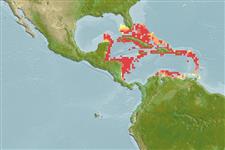>
Blenniiformes (Blennies) >
Labrisomidae (Labrisomids)
Etymology: Malacoctenus: Greek, malakos = soft + Greek, kteis, ktenos = comb (Ref. 45335).
Eponymy: James Erwin Böhlke (1930–1982) and his wife Eugenia Louisa Böhlke née Brandt (1929–2001) were both ichthyologists who worked at the Academy of Natural Sciences of Philadelphia, where he was Curator of Ichthyology (1954–1982). [...] (Ref. 128868), visit book page.
Environment: milieu / climate zone / intervalo de profundidade / distribution range
Ecologia
marinhas associadas(os) a recifes; intervalo de profundidade 5 - 70 m (Ref. 5521). Tropical
Western Central Atlantic: Bahamas and Virgin Islands south to Bonaire and west to Belize.
Tamanho / Peso / Idade
Maturidade: Lm ? range ? - ? cm
Max length : 6.4 cm TL macho/indeterminado; (Ref. 5521)
Espinhos dorsais (total) : 21 - 22; Raios dorsais moles (total) : 11 - 13; Espinhos anais: 2; Raios anais moles: 20 - 23. Upper side has series of dark blotches; lower side has series of diamond-shaped markings (Ref. 26938). Males light brown, finely spotted with white, with an upper row of seven irregular dark-edged brown blotches and a lower row of ten smaller brown blotches of irregular diamond shape with pale centers; females have brownish orange blotches instead of dark brown (Ref. 13442).
Inhabit patch reefs or other deeper water coral formations. Usually associated with Condylactis gigantea (Ref. 9710).
Life cycle and mating behavior
Maturidade | Reprodução | Desova | Ovos | Fecundidade | Larvas
Böhlke, J.E. and C.C.G. Chaplin, 1993. Fishes of the Bahamas and adjacent tropical waters. 2nd edition. University of Texas Press, Austin. (Ref. 5521)
Categoria na Lista Vermelha da IUCN (Ref. 130435: Version 2025-1)
Ameaça para o homem
Harmless
Utilização humana
Ferramentas
Relatórios especiais
Descarregue XML
Fontes da internet
Estimates based on models
Preferred temperature (Ref.
123201): 25.4 - 28.1, mean 27.6 °C (based on 104 cells).
Phylogenetic diversity index (Ref.
82804): PD
50 = 0.5000 [Uniqueness, from 0.5 = low to 2.0 = high].
Bayesian length-weight: a=0.00933 (0.00410 - 0.02122), b=3.10 (2.91 - 3.29), in cm total length, based on LWR estimates for this (Sub)family-body shape (Ref.
93245).
Nível Trófico (Ref.
69278): 3.4 ±0.4 se; based on size and trophs of closest relatives
Fishing Vulnerability (Ref.
59153): Low vulnerability (10 of 100).
🛈
Nutrients (Ref.
124155): Calcium = 123 [66, 225] mg/100g; Iron = 0.811 [0.479, 1.340] mg/100g; Protein = 18.6 [17.5, 19.7] %; Omega3 = 0.188 [0.109, 0.317] g/100g; Selenium = 23.9 [11.5, 46.7] μg/100g; VitaminA = 228 [73, 695] μg/100g; Zinc = 2.17 [1.46, 3.10] mg/100g (wet weight);
